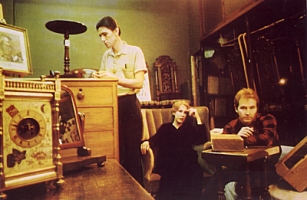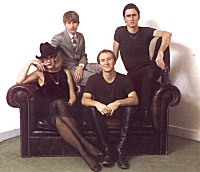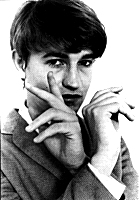 | The Go-Betweens |
Some people have said that the Go-Betweens were a real girls' group, that there was a time when they swooned whenever Robert Forster moved. Such statements may seem provocative and strange, but it's entirely true. Back in those mid eighties summer holiday afternoons by the reservoir, Emma would play 'Before Hollywood' and 'Spring Hill Fair' and would urge me to look more like Robert Forster; enigmatic, dark, poetic. Instead and in spite of this however, I just tried to be more like Morrissey, which was a sorry disease so rife at the time. Looking back now, inevitably with a rose tinted memory, I remember the songs of Forster/McLennan with a far greater degree of fondness than the songs of Morrissey/Marr, and looking back now I also see that The Go-Betweens were one of only a handful of groups to make it through the eighties un-compromised and with a brace of great Pop records to their credit. Only Felt, of the others, really began to come close. To the Rock Majority, however, mention of the eighties brings hushed reverence for who? The Smiths? REM? Both groups who pale when compared to The Go-Betweens. Both those groups' collections of recorded output have gaping holes in them. REM since the mid-decade 'Reconstruction of the Fables' became a far too obvious, intrigue-free Rock band, shorn of the peculiar collisions between traditional American folk music and the asymmetrical punk of British influences Wire and Gang of Four which had given their earlier efforts such poise and mystique. Stupidly, however, it is for the later sounds that they are held in such high esteem. Likewise, The Smiths have been raised to a position of sacred Rock'n'Roll icon and have been surrounded by similar truckloads of bullshit. To suggest that they were not a strange polarising phenomenon in the eighties would of course be idiocy, but nevertheless their artistic contribution has been ludicrously overplayed. The populist view on The Smiths seems to be that 'The Queen Is Dead' was their creative peak, and as such it seems to have acquired some kind of sacred cow status. In reality however the record tails off after its opening salvo, lifting its head only briefly for the singles and the fairly sublime 'There Is A Light'. The rest is a sorry mish-mash of appalling whimsy ('Vicar In A Tutu') or weary depression ('Never Had No-One Ever'); Morrissey over-indulgence whichever way you look at it. There is another view, however, less widely subscribed to, that says The Smiths peaked with 'Hand In Glove'. I prefer this view partly because it makes most of the rock journalists of the eighties look like the desperate hangers-on they most certainly were, and partly because I think it's pretty close to the truth. The Smiths were always at their best when witnessed live. The first times I saw them, in 1983 and 1984 the atmosphere was tense, terse, a raucous celebratory noise. At seventeen I was scratched as fiercely by seeing The Smiths as I had been at thirteen seeing The Jam. The point was that it seemed to be something which ran deeper than the artifice of too much music prevalent in both ages. The sharpness of The Smiths was as vivid in the flailing limbs, outsized blouses and quiff of Morrissey as it had been in Weller's button-downs, mod crop and manic jerking head. Together they synthesised a spirit of kicking violently, passionately and stylishly against the flow of their times. Like The Jam and the young Weller, The Smiths' sound stirred up a storm; the songs themselves were peculiar and twisting, spirals of strange words, imagery lost from Pop for decades. A pyrotechnic wonderland in the midst of weary fancy, The Smiths had the darkness and light of great Pop in their hands. And like the ageing Weller, they just as surely lost their grip. | |
 | By 1985 however, they could still show it, though significantly the sounds that still scratched were the already old standards of 'Hand In Glove', 'Still Ill' or 'What Difference Does It Make', alongside their cover of James' 'What's The World'. But by 1986 even their live performance was, like their records, a pale and flat parody of their once proud, natural awkwardness and isolation. At the Glasgow stop of their 'Queen Is Dead' tour I walked out after half a dozen dreary songs; bored, let down, but already scratched anew by the sounds of support act Stockholm Monsters, whose abrupt and rattling sound had the hardness I once found in The Smiths. For the increasing masses of Morrissey idolaters and music press alike, however, it was as though their chosen messiahs were still in the ascendancy instead of having already slipped so far from their former glories. |
For those masses it was all so easy. Too easy. The stereotypical myth of The Smiths was already written widely in stone tablets which were worn with apparent pride around the necks of both band and fans alike. The reference points were common knowledge, but for every worthy re-discovery of a Shelagh Delaney there was a nonsensical froth of interest in a George Formby. Even the resurgence of interest in the 'gritty Northern' cinema of the '50s and '60s had a ring of irony to it, as The Smiths mirrored the cinematic slide into over-indulgence, un-intentional self-parody and heavy handed production. By the end of the eighties The Smiths, although apparently stirring against the tableau of the mid-decade mainstream, had become nonetheless another loved or loathed English institution. Against this backdrop of one-dimensional weariness, The Go-Betweens, more than anyone else and more than ever before, seemed to be the perfect antidote. Getting anyone to believe that was not easy, however, for to kick against the pricks of Smith-dom in 1986 was tantamount to suicide, particularly for a music journalist. Not that they got bad press, just uninspired and consequently uninspiring. As Kevin Pearce says, "they had the misfortune to be championed by the music press in such a dull way that it must have put The Go-Betweens off The Go-Betweens. The jaded journalists made the Go-Betweens sound worthy, and there is surely no more unglamorous word than worthy." | |
 | The truth was that The Go-Betweens were more peculiarly glamorous than almost anyone else in Pop at the time. Robert Forster was a film-noir movie star who kept the silver screen in his pocket. Grant McLennan was an antipodean Phil Ochs obsessive and sometimes played beside a TV showing Bruce Lee movies. Robert Vickers was a great Mod Face who looked like he was about sixteen, and Lindy Morrison was Virginia Woolf reincarnated as the world's first glamorous drummer. But such glamour was too strange for the record companies to project into the hearts of the Pop consumer. The Little England mentality of Morrissey's Smiths was a convenient coat-tail to latch onto, and as such was remarkably easy to market. The Go-Betweens' trans-continental depths and quirky un-conventionality on the other hand demanded some new way to do things that the company bosses seemed either too lazy, unimaginative or scared to attempt. |
That failure to project The Go-Betweens into the public awareness may have lost Forster/McLennan the battle for fame and fortune against Morrissey/Marr, but it did nothing to prevent their successes as songwriters eclipsing the Manchester duo's efforts. As the passing of time blunted the effects of The Smiths' records, so it allowed those of The Go-Betweens to grow and flourish, and on the altar of Pop that was my beat up record player, if not those of the deadened masses, it was increasingly 'Spring Hill Fair' that displaced 'Meat Is Murder'. And in 1986, 'Liberty Belle & The Black Diamond Express' soared effortlessly in stratospheres which 'the Queen Is Dead', stomping around clumsily on terra-firma could only dream of aspiring to. In the realm of the classic Pop single too - an area in which the Smiths liked to think they excelled - The Go-Betweens strolled along and took the crown with ease. As that summer became autumn it was the likes of 'Spring Rain'. 'Head Full Of Steam', 'Man O'Sand To Girl O'Sea' and 'Hammer the Hammer' that set the falling leaves on fire. By the time winter shrouded Scotland in rains and bitter winds, the re-discovered classics of 'Part Company' (with the unforgettably mournful 'that's her handwriting, that's the way she writes'), 'Bachelor Kisses' and the truly sublime 'Cattle And Cane' (who can forget a line like 'his father's watch, he left it in the shower'?) easily held sway on the troubled moody window gazed afternoons. Only 'How Soon Is Now' could keep The Smiths even vaguely in the running, but even that could do nothing to rescue the situation as 1997 began with the lacklustre 'Shoplifters Of the World Unite' being left wallowing in the vapour trail of the almost concurrently released 'Right Here'. | |
 | Only Grant McLennan and his associates could tell that 'Right Here' was about addiction to chemicals used in funeral parlours, but it gives a typical twist to a song that otherwise appears to do everything that perfect Pop ought to. Scott heard it first when he was on guard duty on the main gate at RAF Lossiemouth, and when I saw him the next weekend he told me he knew right there and then that it was the best Pop song ever recorded. I was in no mood to argue. Later that same night we cycled over to Jon's house where we drank wine and talked with his mom and his sister. Coming home, we stood together at the top of the hill looking down on the town lights. And although it was only February, we laughed together like it was the first day of Spring. |
The flip side of the single was 'When People Are Dead', and it was the most poignant perfect companion to 'Right Here' imaginable. With words by Irish poet Marion Stout, 'When People Are Dead' was the shadow cast by the other side's blossoming light. Far from the heavy handed treatment that The Smiths could shovel onto such a subject, The Go-Betweens presented a lovingly crafted portrayal of innocence and loss and. as Robert says in the notes of the '1978 - 1990' LP, "the band sounds absolutely great." When Scott died three years later, 'When People Are Dead' was the song I played before I went to his funeral, 'Right Here' the one I played when I got home again. And I don't fucking care if you think that sounds dumb as hell. That's Pop. In 1987 I wore a blue plastic motorcycle on my lapel in place of a 'Meat Is Murder' badge, Alan and I sang 'My Best Friend' at the tops of our voices at Troon cross on a Saturday afternoon, and I told anyone who would listen that I was in love with a girl who looked like Amanda Brown. One night that summer we smashed our beer glasses on the floor of the discotheque and walked arm in arm over the golf courses to home, giggling at the stars. I was worried about tornadoes in Toronto and the state of my father's rose garden. That summer, to put it in a nutshell, my life changed from theatrical self-pity to Technicolor celebration, the Go-Betweens released 'Tallulah' and The Smiths split up. These things were not unconnected. 'Tallulah' lit out into the world in June and blazed a trail all the way into and over The Smiths' September swansong of 'Strangeways Here We Come'. Both groups delivered on expectations, both records flying or falling to their respective futures and fates. Gleefully we danced on the Last of England, and 'Bye Bye Pride' was the epitaph we sang for it. Ironically enough though, The Go-Betweens' own finale came less than a year later, as 'Streets Of Our Town' echoed both 'Right Here's success as a classic Pop song and its failure to threaten the charts. The subsequent final and gorgeously accomplished LP '16 Lovers Lane' broke the unwritten rule by not including a double 'l' in the title, and if ever there was an ill omen then this was it. It was of course still a great record, in hindsight possibly one of their finest, and included one of their best ever songs in 'Love Is A Sign'. It also followed true to form by gathering 'worthy' critical acclaim, and bombed commercially. The bands actual demise however was an affair that tailed out over a year or two into shrugged resignations. Beggars Banquet tried one final time to push 'The Streets Of Your Town' into the public domain but, ten months after the first time, the imagination and commitment of promotion was as lacking as before. The rock press were gleefully lauding The Stone Roses and all things Madchester, and The Go-Betweens slipped away almost without anyone even noticing. The Official End came with the '1978 - 1990' double compilation, a record that stands alone as a classic example of collected class, style, passion and regret. Next to this, The Smiths' 'Best' volumes or 'Louder Than Bombs' even, look like shoddy, empty vessels. Writing this, I'm aware that there is an enormous number of people who will testify to the fact that 'The Smiths changed my life'. To many of these people, what I have just written will seem like heinous trash. Similarly, rock journalists might say that this is elitist snobbery after the fact, that The Smiths were our generation's Beatles and will knee-jerk, knee-jerk, knee-jerk into oblivion forevermore. They'll wallow in their words and in another ten years a new generation will saying that Suede were their generation's Smiths, and so on, ad nauseum. But in the end who really cares? Each of us will write our own history anyway. This has been a part of mine. Go invent your own. © Alistair Fitchett 1996. | |